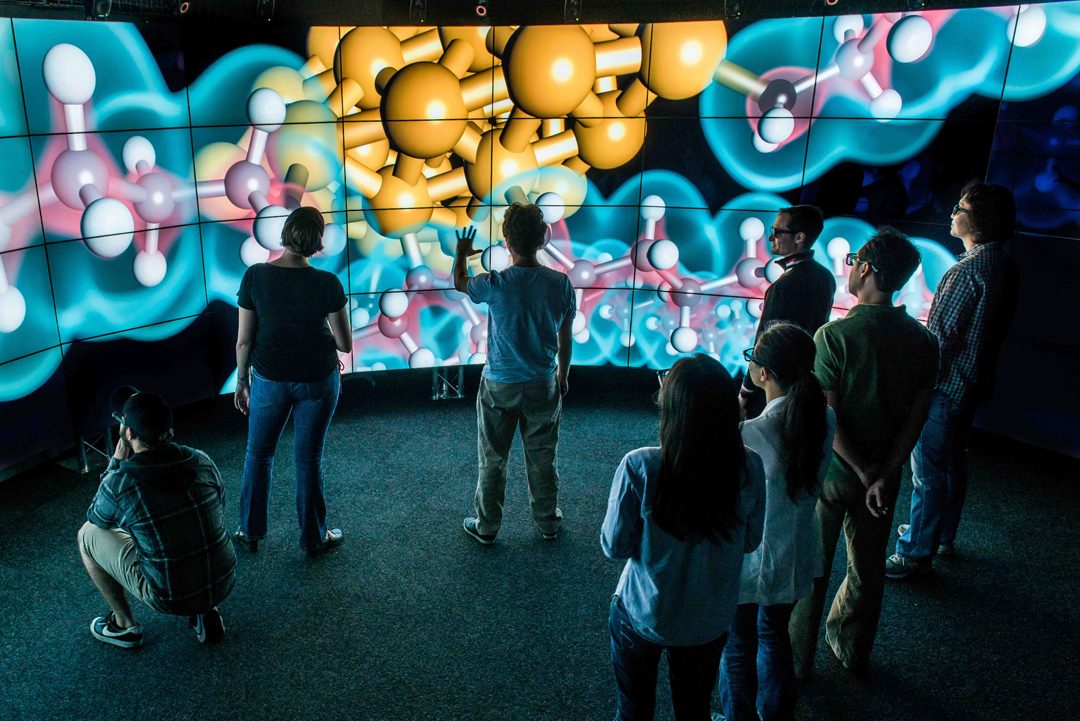CAVE2™ - An Advanced Cyberworld for Data Exploration
October 3rd, 2012
Categories: Devices, Visualization, VR

About
CHICAGO, OCTOBER 3, 2012 - Today, most professions rely on computers to capture, filter, analyze and visualize data. When studying phenomena too large, too small, too dangerous, too complex or too distant to truly understand well, virtual reality provides people with an alternate reality - transporting them to worlds inside cyberspace where they can be immersed in their data in order to glean understanding. Once inside these cyberworlds, people can change their size and their perspective, make observations, and gain insight and knowledge.
Imagine being larger than a six-story building, being smaller than a molecule, standing inside train tracks to observe distortion as high-speed trains roar past, seeing blood flow through the brain’s vasculature, or traveling to Mars. And, while exploring these cyberworlds of visual information, imagine one can also call up related data and documentation, whether diagrams, formulas, spreadsheets, or research documents. This is no longer science fiction - with CAVE2, it’s science fact.
CAVE2, the next-generation large-scale virtual-reality environment, is a hybrid system that combines the benefits of both scalable-resolution display walls and virtual-reality systems to create a seamless 2D / 3D environment that supports both information-rich analysis and virtual-reality simulation exploration at a resolution matching human visual acuity.
CAVE2 is being developed by the Electronic Visualization Laboratory (EVL) at the University of Illinois at Chicago (UIC), a renowned interdisciplinary research laboratory that pioneered the development of the CAVE™ virtual-reality system in 1992 and the OptIPortal scalable-resolution display wall in 2004. Both these displays, deployed to hundreds of research, industrial and educational researchers and developers worldwide, enable users to see and navigate through complex datasets. Because of EVL’s history, notes Director Jason Leigh, “the CAVE2 is the culmination of the Lab’s 20+ years of expertise in virtual-reality and in large-scale displays to create a unified hybrid 2D/3D environment.”
CAVE2 is approximately 24 feet in diameter and 8 feet tall, and consists of 72 near-seamless passive-stereo off-axis-optimized 3D LCD panels, a 36-node high-performance computer cluster, a 20-speaker surround audio system, a 10-camera optical tracking system and a 100-Gigabit/second connection to the outside world. CAVE2 provides users with a 320-degree panoramic environment for displaying information at 37 Megapixels in 3D or 74 Megapixels in 2D with a horizontal visual acuity of 20/20 - almost 10 times the 3D resolution of the original CAVE.
To build CAVE2, in 2010 EVL received funding from a U.S. National Science Foundation economic stimulus grant and immediately began working with Planar Systems, a U.S. company and global leader of display technology. At the time, thin-bezel, flat-panel, passive-stereo displays were not commercially available, so EVL consulted Planar and Planar was able to design the Clarity™ Matrix 3D LCD Video Wall,, which launched in January 2012. These systems were fine for the middle rows of CAVE2, but to a person standing inside CAVE2, the information displayed along the top and bottom rows would appear ghosted. With the Clarity Matrix 3D LCD Video Wall, the team was able to accommodate the off-axis vertical viewing angles.
EVL is currently talking with a potential commercialization partner, as there is already interest from several research partners in being early adopters of this technology. CAVE2 will benefit large-scale collaboratories of discipline scientists in need of advanced cyberinfrastructure, providing them with new and more intuitive ways of interacting with their data. And, CAVE2 will benefit computer scientists interested in providing knowledge workers with better ways to manage the scale and complexity of their data, by enabling them to study a wide range of new problems at the intersection of human-computer interaction, virtual reality, computer graphics, high-performance computing, high-speed networking, and computer-supported cooperative work.
CAVE2 debuts the week of October 8, 2012, with demonstrations performed in cooperation with Chicago Ideas Week, the 12th Annual Global LambdaGrid Workshop sponsored by the Global Lambda Integrated Facility (GLIF), and the UIC College of Engineering’s Industrial Advisory Board. Thereafter, EVL will host occasional open houses for the university community and general public; information regarding open houses will be published on EVL’s website.
CAVE2 is funded by the National Science Foundation’s Major Research Instrumentation (MRI) program, award # CNS-0959053 and the Department of Energy, agreement # DE-SC005067. CAVE2 is a trademark of the University of Illinois Board of Trustees.
UIC / EVL Contact
Maxine D. Brown
Associate Director, Electronic Visualization Laboratory, University of Illinois at Chicago
maxine @ uic.edu
UIC Office of Public Affairs Contact:
Jeanne Galatzer-Levy
Jgala @ uic.edu
UIC College of Engineering Contact:
Joel Super
jsuper @ uic.edu
Planar Contact:
Kim Brown
kim.brown @ planar.com
Additional information
EVL
CAVE2
CAVE2 Trailer
Original CAVE
OptIPortal
SAGE
Chicago Ideas Week
UIC NEWS: Showcase for innovation, ideas
GLIF 2012 Workshop
UIC NEWS story “Learning in 3-D”
UIC / EVL Partners with Industry to Advance 3D Visualization Display Technology
Planar Clarity Matrix
Planar UIC / EVL Case Study
Photo
Khairi Reda, an EVL research assistant and computer science PhD candidate, shows this visualization of a balls-and-sticks model of a molecular chemistry dataset to fellow students in EVL’s CAVE2 virtual-reality environment. The clouds represent the density of electrons around atoms. Chemistry models and simulation data provided by Aslihan Sumer, Juliuis Jellineck and Micheal Papka, Argonne National Laboratory.